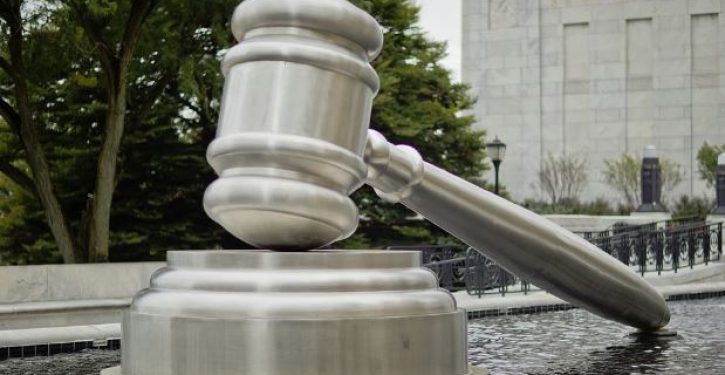
Anti-police progressives claim the criminal justice system is racist because blacks are incarcerated at a higher rate than whites. But that ignores the fact that the black crime rate is higher than the white crime rate. After taking into account the higher black crime rate, it becomes clear that the criminal justice system treats similarly-situated blacks and whites alike, the vast majority of the time.
“Overall, the criminal justice system appears to be remarkably neutral” and evenhanded in terms of how it treats people of different races, finds a new meta-analysis. It also finds that race is not a predictor for most criminal sentencing outcomes. “Overall results suggested that neither class nor race biases for criminal adjudications for either violent or property crimes could be reliably detected,” reports the study, “Race, class, and criminal adjudication: Is the US criminal justice system as biased as is often assumed? A meta-analytic review.” It is published in Aggression and Violent Behavior, a peer-reviewed scientific journal published by the leading academic publisher Elsevier.
This finding that the criminal justice system is racially fair is consistent with a recent government study as well.
A 2021 study by the federal Bureau of Justice Statistics found that although blacks are arrested for serious nonfatal violent crimes at much higher rate than whites, this mostly reflected underlying crime rates, not racism: “white and black people were arrested proportionate to their involvement in serious nonfatal violent crime overall and proportionate to their involvement in serious nonfatal violent crime reported to police.” (See Allen J. Beck, Race and Ethnicity of Violent Crime Offenders and Arrestees, 2018). The fact that the black percentage of people arrested was similar to the black percentage of perpetrators of “crime reported to police” is telling, because the people who report violent crimes to police — mainly crime victims — are disproportionately black people themselves. Since victims are overwhelmingly the same race as their attacker, there is no reason to think that they are reporting those crimes out of racism. Most crimes against black people are black-on-black, according to the federal Bureau of Justice Statistics. According to FBI data, 89 percent of blacks who were murdered in 2018 were killed by black offenders.
Other studies have also found the criminal justice system is racially unbiased in key respects. The RAND Corporation statistical expert Dr. Stephen P. Klein, a left-leaning researcher, looked carefully at California’s state criminal justice system and, controlling for relevant variables, found that criminal sentencing in California was racially fair and non-discriminatory, overall, and that blacks and whites in California who were similarly-situated got very similar sentences. (See Stephen P. Klein, et al., “Race and Imprisonment Decisions in California,” 247 Science 812 (1990)).
Similarly, a 1991 RAND Corporation study of adult robbery and burglary defendants in 14 large U.S. cities found that a defendant’s race or ethnic group bore almost no relation to conviction rates, sentencing severity, or other key measures. In 1994, federal government statistician Patrick A. Langan analyzed data on 42,500 defendants in the nation’s 75 largest counties and found “no evidence that, in the places where blacks in the United States have most of their contacts with the justice system, that system treats them more harshly than whites.” As he noted, “No Racism in the Justice System,” “Many studies have been conducted that show no bias in the arrest, prosecution, adjudication, and sentencing of blacks,” while “other studies show possible evidence of bias.”
What, then, explains why blacks are overrepresented in America’s prisons? The higher black crime rate. Rates of committing homicide “for blacks were more than 7 times higher than the rates for whites” between 1976 and 2005, according to the federal Bureau of Justice Statistics in its publication, Homicide Trends in the United States. In 2019, 6,425 black people committed homicide, compared to only 4,728 white people, according to the FBI’s Uniform Crime Report.
Racial differences in incarceration rates are not due to “white supremacy.” If they were, the Asian incarceration rate would be higher than the white incarceration rate. But it’s just the opposite: Asians, who are not white, have the lowest incarceration rate by far, of any race. Asians are 15% of California’s population, but only 2% of its jail population — a huge racial disparity. Nationally, less than 2% of the jail population is Asian or Pacific Islander, even though they account for more than 6% of the U.S. population.
Progressives sometimes claim that it is racist to point out that the black crime rate is higher than the white crime rate, or that if the black crime rate really is higher than the white crime rate, then that is society’s fault. Responding to the meta-analysis, a progressive with lots of followers on X (formerly known as Twitter) said that since “minority populations is over-represented in prisons,” then one must believe either that minorities “are essentially more violent”; or that the legal system is to blame because it “is built to justify condemning different cultures” or to deny minorities “a good defense.” Not believing the latter is “bigotry,” he claimed.
But these are not the only possibilities. The black crime rate could be higher for cultural reasons, not just because they are “essentially more violent.” After all, blacks in America spent generations in criminogenic cultural environments, and blacks today grow up mostly in single-parent households, which disproportionately generate criminals.
As the Manhattan Institute’s City Journal notes,
Over 70 percent of black children are born out of wedlock, far higher than in any other racial group. The social science correlating fatherlessness with criminal behavior is overwhelming. A famous study conducted on juvenile delinquency in 2002 at UC–Santa Barbara concluded that “the most critical factor affecting the prospect that a male youth will encounter the criminal justice system is the presence of his father in the home.” Sadly, the single-parent-family rate among black Americans has hovered at about 65 percent for the past decade. Non-Hispanic whites have a rate of 24 percent, and Asian-Americans have the lowest rate, at 15 percent.
Most blacks once lived in the Deep South, which historically had a higher crime rate than most of the U.S., for cultural reasons explained by David Fischer in Albion’s Seed. Even before blacks picked up bad influences from that culture (and were brutalized by violent white overseers), they already carried with them the habits of African cultures where killing was routine and human life was regarded as cheap. A Nigerian-American wrote about the violent history of his people, the Igbos, in The New Yorker:
Long before Europeans arrived, Igbos enslaved other Igbos as punishment for crimes, for the payment of debts, and as prisoners of war….they were also sometimes sacrificed in religious ceremonies or buried alive with their masters to serve them in the next life. When the transatlantic trade began, in the fifteenth century, the demand for slaves spiked. Igbo traders began kidnapping people from distant villages. Sometimes a family would sell off a disgraced relative…..[My great-grandfather] was so esteemed that, when he died …. six slaves were buried alive with him.
That Nigerian-American was writing about one of Africa’s more advanced peoples, the Igbo of southeastern Nigeria, who have been called the “Jews of Nigeria” because of their intelligence and cleverness. But even among that relatively advanced African people, killings and violence were routine.
Everyday disputes were resolved violently in Africa. African cultures had underdeveloped legal systems and traditions of using violence to resolve disputes that would be resolved peacefully in Europe. Christopher Columbus and his heirs sued the monarchs of Spain, with partial success. Peasants sued their feudal lords in 19th Century France. Any one who did that sort of thing in Africa would have been killed for their effrontery by their ruler.
Black slaves were imported into the most violent part of America, the Deep South, which may also have had negative effects on law and order in the black community. Black economist Thomas Sowell “theorized that Southern blacks adopted the [violent] honor culture of Southern whites and then carried it into the North during the Great Migration, along with illiteracy and unemployment. Northern states were populated by a more sophisticated set of English migrants, whereas the South was populated by Englishmen from more antisocial cultures. This is perhaps why, in early twentieth-century Pennsylvania, the Southern black crime rate was five times higher than that among Northern-born blacks,” explains the City Journal.
Moreover, black-on-black crime has historically often been ignored by the legal system, incubating crime in the black community. That mindset was summarized by a viciously racist Southern police chief, who infamously said: “If a nigger kills a white man, that’s murder. If a white man kills a nigger, that’s justifiable homicide. If a nigger kills a nigger, that’s one less nigger.” (See Popular Justice: A History of Lynching in America, pg. 116). Since most violent crimes by blacks are against other blacks, turning a blind eye to black-on-black crimes results in the black crime rate being higher than the white crime rate.
The racial differences in arrest rates that exist today do not prove racism by the police making the arrests. In an 8-to-1 ruling, the Supreme Court emphasized that there is no legal “presumption that people of all races commit all types of crimes” at the same rate, since such a presumption is “contradicted by” real world data showing big differences in crime rates. Thus, racial disparities in arrest or incarceration rates don’t violate the Constitution’s ban on racial discrimination (See United States v. Armstrong (1996)).



